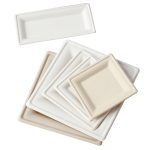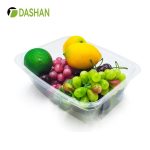Quick Summary
PET packaging is the leading choice for maximizing the shelf life of food products, providing exceptional protection against moisture, oxygen, and UV light. This packaging material is ideal for preserving the freshness of various food items, including salads, bakery products, and ready-to-eat meals. With its durability, recyclability, and ability to withstand temperature fluctuations, PET ensures both product quality and sustainability. This article explores the benefits of PET packaging in maintaining food freshness, extending shelf life, and offering an eco-friendly packaging solution.
Introduction
In today’s fast-paced world, consumers expect fresh food with a long shelf life, whether it’s a healthy salad, a delicious bakery item, or a ready-to-eat meal. Packaging plays a pivotal role in ensuring that food items remain fresh for as long as possible, maintaining flavor, texture, and nutritional value. Among the various materials used for food packaging, PET (Polyethylene Terephthalate) has emerged as a clear winner.
In this article, we will explore the unique properties of PET packaging, how it helps maximize product shelf-life, and why it is the material of choice for food manufacturers globally. Along the way, we’ll highlight some popular PET-based products from our catalog, including PET salad containers, bakery containers, and CPET trays.
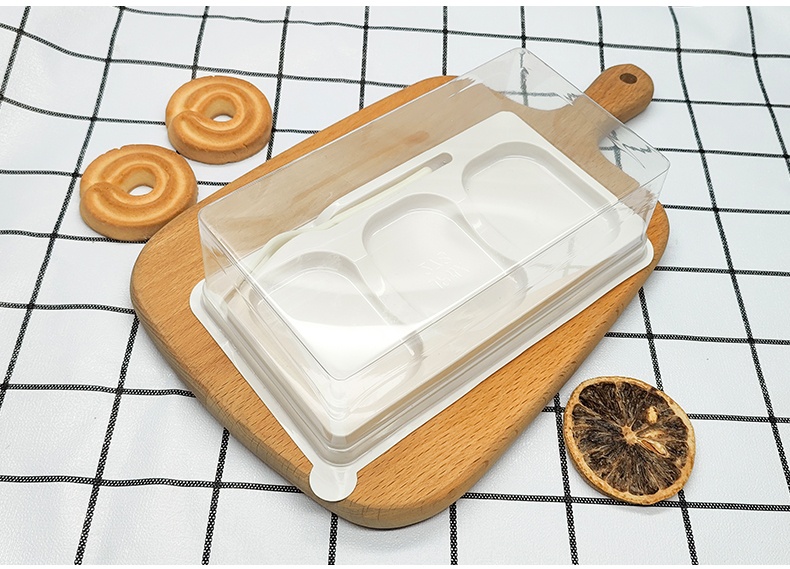
What is PET Packaging?
PET packaging is a type of thermoplastic polymer widely used in the food industry due to its unique properties. It is transparent, strong, durable, and lightweight, making it ideal for packaging various food products, from fresh salads and bakery items to takeout meals. PET is often used for making food containers, bottles, and trays, ensuring that food stays fresh, visible, and safe for longer periods.
The chemical structure of PET allows it to resist moisture, gases, and contaminants that could otherwise affect the quality of food. PET can be easily molded into various shapes, including containers for fresh produce, bakery goods, and ready-to-eat meals, while also being a lightweight and cost-effective solution.
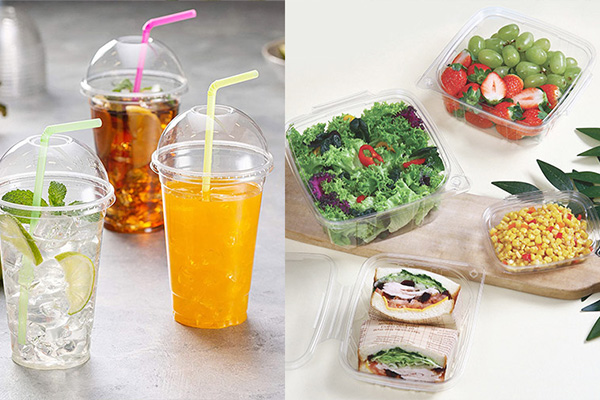
Why PET is the Best Packaging for Freshness
One of the primary reasons PET has become the material of choice for food packaging is its excellent ability to maintain the freshness of products. PET containers create a protective barrier that helps preserve food by limiting exposure to air, moisture, and light, all of which are key factors in food spoilage.
Key Benefits of PET Packaging:
-
Barrier properties: PET offers superior protection against oxygen, carbon dioxide, and water vapor, which are essential for keeping foods fresh. This helps to preserve the flavor, texture, and nutritional value of products.
-
UV protection: PET packaging protects products from ultraviolet (UV) light, which can degrade the color and flavor of many foods. This is particularly important for packaging items like fresh fruit, bakery goods, and ready-to-eat meals.
-
High transparency: The clarity of PET allows consumers to see the food inside, providing visual appeal and promoting customer confidence in the freshness of the product.
The Shelf-Life Benefits of PET Packaging
Maximizing shelf life is one of the most important factors for food manufacturers. The longer a product can stay fresh on the shelf, the better it performs in terms of sales and waste reduction. PET packaging excels in extending shelf life due to the following reasons:
Moisture and Oxygen Control
PET containers have high resistance to moisture and oxygen permeation, two factors that accelerate food spoilage. By limiting the exposure of food to oxygen, PET helps prevent oxidation, which can cause food to lose flavor, color, and nutritional value. This makes PET packaging ideal for packaging products like fresh salads, bakery items, and ready-to-eat meals.
Temperature Control
PET is known for its ability to retain heat and cold, making it perfect for maintaining the temperature of products, whether hot or cold. For example, CPET trays, a variant of PET, can withstand higher temperatures, making them suitable for hot food items like baked goods and ready-to-eat meals. Conversely, standard PET salad containers maintain a chilled environment for fresh salads, reducing the risk of wilting or spoilage.
Long-Term Freshness Preservation
For items like fresh produce or bakery products, the ability to keep moisture and air out is essential to maintaining freshness. PET containers with tight-sealing lids, such as PET bakery containers or salad boxes, help prevent moisture loss, which can otherwise cause items like bread to dry out or salads to wilt.
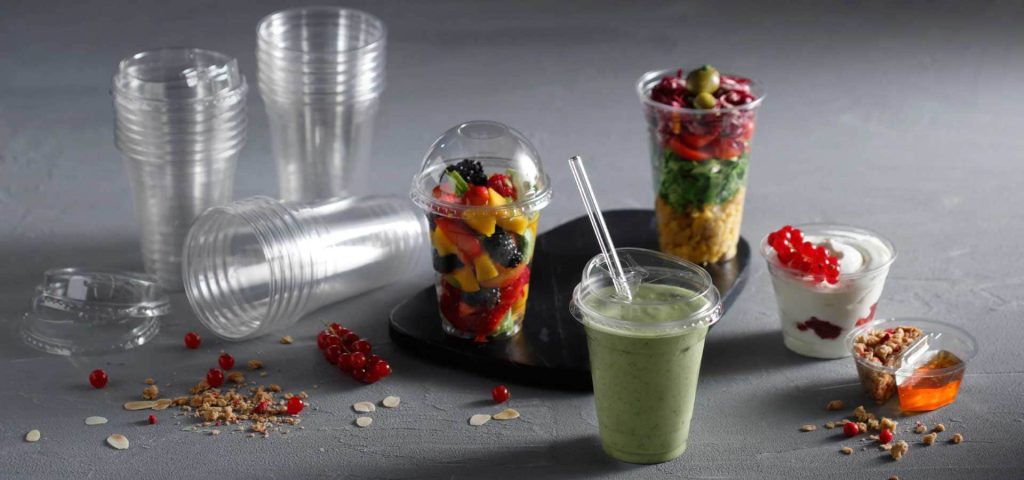
How PET Helps with Temperature Control and Freshness
Temperature control is essential for the preservation of food, especially for items that are sensitive to changes in heat. PET packaging allows for efficient temperature management in multiple food sectors, including the following:
-
Ready-to-eat meals: Packaging such as CPET trays (e.g., CT-1610H35-1C) ensures that meals can be safely reheated in the microwave without compromising quality.
-
Fresh fruit and salads: For fresh-cut fruit and salads, PET salad containers (e.g., DS-250G and DSSC-43oz) maintain the right temperature and protect the produce from external contaminants.
-
Baked goods: PET bakery containers (e.g., DS-TW808 and DS-CH118) prevent moisture loss while keeping products like cakes, cookies, and bread fresh for longer periods.
The Eco-Friendly Advantages of PET Packaging
As consumers become more eco-conscious, PET packaging provides several sustainability advantages. While PET is a plastic material, it is highly recyclable, making it an environmentally friendly choice for food packaging.
-
Recycling: PET is one of the most commonly recycled materials in the world. It can be easily repurposed into new packaging, reducing the need for virgin plastic and contributing to a circular economy.
-
Lightweight: PET is much lighter than many other packaging materials, reducing transportation costs and the carbon footprint associated with shipping.
-
Durability: The durability of PET means that it has a long shelf life and can be reused multiple times, decreasing the amount of waste generated by single-use packaging.
Popular PET Packaging Options for Different Food Types
Different food products have unique packaging needs. Fortunately, PET packaging is versatile enough to meet the demands of various food categories. Here are some popular PET-based products in our catalog:
-
PET salad containers: Models like DS-250G and DS-500A are perfect for fresh salads, keeping ingredients fresh and crisp.
-
PET bakery containers: DS-TW808 and DS-SS02 are excellent for bakery products, maintaining freshness while offering a clear view of the products inside.
-
CPET trays: CT-1610H35-1C and CT-2121H30-1C provide the perfect solution for takeout food, offering both durability and microwave-safe properties.
FAQ: Common Questions About PET Packaging
Q1: Is PET packaging safe for food?
Yes, PET packaging is completely safe for food storage. It is FDA-approved for direct food contact and is widely used for packaging various food products, including beverages, salads, and bakery goods.
Q2: Can PET containers be microwaved?
Yes, PET containers can withstand heat to a certain degree. CPET trays, in particular, are designed to be microwave-safe and are perfect for reheating meals without compromising the container’s integrity.
Q3: How does PET compare to other materials for food packaging?
When compared to other materials like PLA or paper-based packaging, PET offers superior barrier protection against oxygen and moisture. This ensures longer shelf life and better preservation of food freshness.
Q4: How can I recycle PET containers?
PET is 100% recyclable. After use, it can be dropped off at recycling centers, where it can be repurposed into new products, including new packaging, clothing, or insulation materials.
Q5: Are PET containers environmentally friendly?
While PET is a plastic material, it is highly recyclable and lightweight, reducing carbon emissions during transportation. It offers a more sustainable option compared to non-recyclable materials.
Conclusion
PET packaging is the optimal solution for maximizing product shelf life in the food industry. With its ability to preserve freshness, control moisture and temperature, and provide eco-friendly benefits, PET continues to be the material of choice for food manufacturers globally. Whether you’re looking for PET bakery containers, CPET trays, or PET salad containers, this material offers a combination of performance, sustainability, and cost-effectiveness.
As the demand for high-quality food packaging increases, PET is set to play an even more significant role in keeping food fresh, safe, and environmentally responsible. Embrace the benefits of PET packaging today and ensure your products stay fresher for longer.
References
-
“Polyethylene Terephthalate (PET) for Food Packaging: The Benefits and Challenges.” Food Quality and Safety Journal, 2023.
https://www.foodqualityandsafety.com/articles/polyethylene-terephthalate-pet-for-food-packaging-the-benefits-and-challenges/ -
Li, Y., et al. “Barrier Properties of PET and CPET in Food Packaging.” Journal of Food Packaging Technology, 2022.
https://www.foodpackagingtech.com/research/barrier-properties-pet-cpet-food-packaging -
“Sustainable Packaging Solutions: The Role of Recyclable Materials in Food Packaging.” Sustainability in Packaging, 2021.
https://www.sustainabilityinpackaging.com/articles/sustainable-packaging-solutions-role-recyclable-materials -
“The Environmental Benefits of PET Packaging.” Plastic Recycling Council, 2021.
https://www.plasticrecyclingcouncil.org/environmental-benefits-of-pet-packaging -
Smith, J. “Maximizing Food Freshness: How PET Packaging Extends Shelf Life.” Food Preservation and Packaging, 2022.
https://www.foodpreservationandpackaging.com/articles/maximizing-food-freshness-how-pet-packaging-extends-shelf-life


